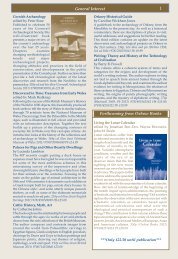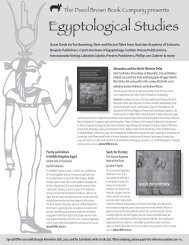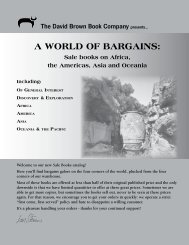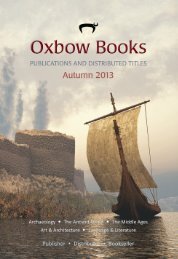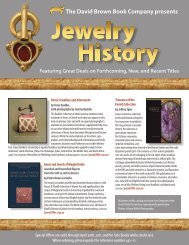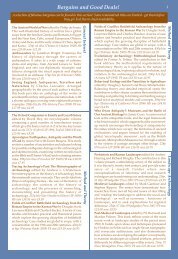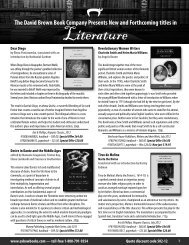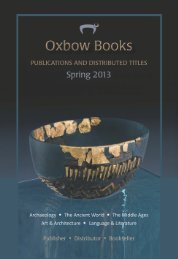New Distributed Titles Fall 2009 - Oxbow Books
New Distributed Titles Fall 2009 - Oxbow Books
New Distributed Titles Fall 2009 - Oxbow Books
Create successful ePaper yourself
Turn your PDF publications into a flip-book with our unique Google optimized e-Paper software.
the ancient near east<br />
Nomads, Tribes, and the State<br />
in the Ancient Near East<br />
Cross-disciplinary Perspectives<br />
edited by Jeffrey Szuchman<br />
The Oriental Institute’s fourth annual postdoc<br />
seminar brought together archaeologists,<br />
historians, and anthropologists to discuss<br />
new approaches to enduring questions<br />
in the study of nomadic peoples, tribes, and<br />
states of the past. This volume presents<br />
a range of data and theoretical perspectives<br />
from a variety of regions and periods, including prehistoric Iran, ancient<br />
Mesopotamia and Egypt, 7th-century Arabia, and 19th-century Jordan.<br />
304p, 70 figs, 7 tbls, paperback, 9781885923615, $24.95, The Oriental Institute of<br />
the University of Chicago, March <strong>2009</strong>, Oriental Institute Seminars 5.<br />
Elaiussa Sebaste<br />
A Port City Between East and West<br />
An Archaeological Guide<br />
by Eugenia Equini Schneider<br />
The ancient city of Elaiussa Sebaste (today Ayas)<br />
lies on the southeastern coast of Turkey. The<br />
city owes its development to its favorable geographical<br />
position, situated along the important<br />
coastal road connecting Asia Minor to Syria, and<br />
to abundant natural resources of the hinterland.<br />
176p, illus, paperback, 9789944483230, $37.95,<br />
Homer Kitabevi, December 2008.<br />
24<br />
Pilgrimage in Early Christian Jordan<br />
A Literary and Archaeological Guide<br />
by Burton MacDonald<br />
The region east of the Jordan River has so far been little explored by pilgrims and<br />
tourists to the Holy Land. Yet, many Biblical events are said to have taken place here:<br />
Moses seeing the Promised Land, the ascension of the prophet Elijah, and John the<br />
Baptist’s ministry and beheading, to name but a few. After a general introduction of<br />
each site, its Biblical significance, and the relevant Biblical sources, the author lists<br />
the literary sources that pertain specifically to early Christian pilgrimage activity.<br />
This information is complemented with a description of the early Christian archaeological<br />
remains found at the site and their interpretation. Illustrated throughout<br />
with maps, plans, and photographs, the volume includes travel directions as well as suggestions about visits to the sites.<br />
c. 296p, 64 col & 25 b/w illus, paperback, 9780977409495, $29.95, Bannerstone Press, December <strong>2009</strong>.<br />
The Excavations at Dura-Europos<br />
– Final Report VII<br />
The Arms and Armour<br />
<strong>New</strong> in paperback!<br />
and other Military Equipment<br />
by Simon James<br />
This is a paperback reprint of the first edition, which appeared in 2004. The ancient<br />
city of Dura-Europos, destroyed by a Sasanian Persian siege in the AD 250s, was an<br />
important regional center of commerce, government and military control under the<br />
Seleucid, Parthian and Roman empires. Found during excavations in the 1920s and<br />
1930s was perhaps the most important single collection of arms, armor and other<br />
equipment to survive from the Roman period, a collection which is exceptional in<br />
its size, diversity and state of preservation. This book provides a complete catalogue<br />
of the military artifacts and analyses and assesses their cultural affiliations and uses<br />
by combining the archaeological evisence with the equally rich and rare textual and<br />
representational evidence in the form of papyri, graffiti and wall-paintings.<br />
456p, 141 b/w & 13 col illus, paperback, 9781842173718, $80.00, <strong>Oxbow</strong> <strong>Books</strong>,<br />
December <strong>2009</strong>.<br />
Pessinous<br />
Sacred City of the Anatolian Mother Goddess<br />
by Inge Claerhout and John Devreker<br />
Pessinous, the sacred city of the Anatolian Mother<br />
Goddess Kybele, is situated on the Anatolian plateau,<br />
about 150 km southwest of Ankara. According to tradition,<br />
the site dates back to the Phrygian era as a cult<br />
site and settlement. The famous King Midas himself is<br />
supposed to have founded Pessinous and erected the<br />
first sanctuary of Kybele in the 8th century BC.<br />
204p, illus, paperback, 9789944483209, $37.95,<br />
Homer Kitabevi, December 2008.<br />
The David Brown Book Company – <strong>Fall</strong> <strong>2009</strong>




